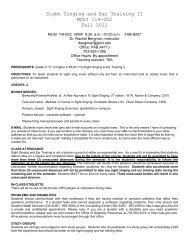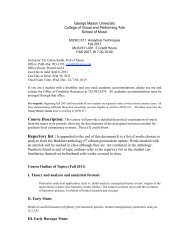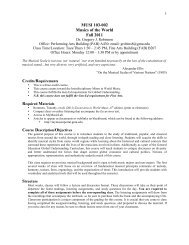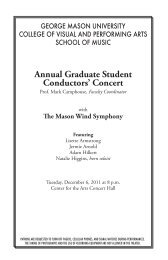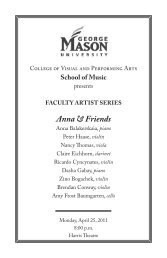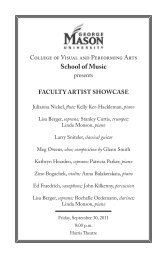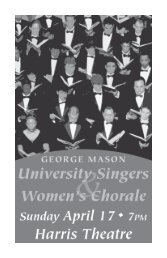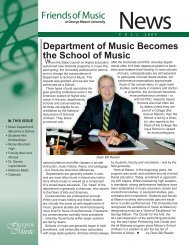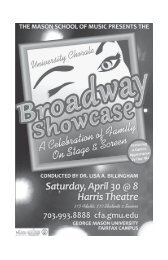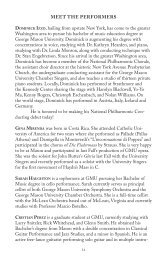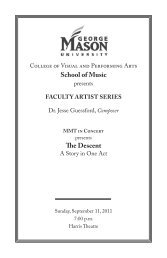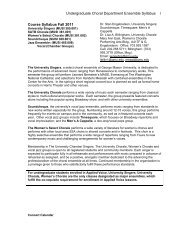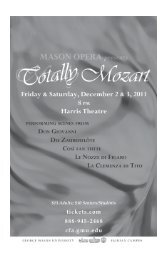complete recital program - George Mason University School of Music
complete recital program - George Mason University School of Music
complete recital program - George Mason University School of Music
Create successful ePaper yourself
Turn your PDF publications into a flip-book with our unique Google optimized e-Paper software.
Ich will nicht, hab’ genug! I don’t want to; I have enough!<br />
Wer mir beim Trinken nicht pariert, Anyone who doesn’t keep drinking<br />
with me<br />
Sich zieret wie ein Tropf, And refuses like a ninny,<br />
Dem werfe ich ganz ungeniert, I throw, quite unashamedly,<br />
Die Flasche an den Kopf. The bottle at his head.<br />
Und fragen Sie, ich bitte, And would you ask me please,<br />
Warum ich das denn tu’? Why I do that?<br />
‘S ist mal bei mir so Sitte, It’s simply my custom:<br />
Chacun à son goût! Each to his own taste!<br />
Witold Lutoslawski (1913-1994)<br />
Variations on a theme <strong>of</strong> Paganini<br />
Wariacje na temat Paganiniego (1941)<br />
Witold Lutoslawski was a polish composer, pianist, and conductor. He<br />
began to study the piano at the age <strong>of</strong> six and studied theory and composition<br />
with Maliszewski at Warsaw Conservatory and in Hamburg. As<br />
many other musicians, his career as a composer was interrupted with the<br />
outbreak <strong>of</strong> World War II. During the German occupation <strong>of</strong> Poland,<br />
the Germans had banned public concerts so that he worked as pianist in<br />
Warsaw cafés with another composer, Andrezj Panufnik. The duo made<br />
over two hundred arrangements, from Bach to Debussy and Ravel. Unfortunately,<br />
the only composition <strong>of</strong> his to have survived from this period<br />
is the Variations on a Theme <strong>of</strong> Paganini for two pianos (1941). 1<br />
In this piece, Lutoslawski follows the scheme <strong>of</strong> Paganini’s wellknown<br />
Caprice, but added a harmonic dimension to it. He recalled: “As<br />
a basis I took Paganini’s 24 th Caprice for solo violin and my Variations<br />
closely follow his model. In each Variation I translate the violin line for<br />
the keyboard. Polyharmony <strong>of</strong>ten occurs between the two keyboards but<br />
tonality remains a clear force with frequent traditional dominant-tonic<br />
cadences.” In 1977, he revised these variations as a Concerto for Piano<br />
and Orchestra, asked by the pianist, Felicja Blumental, who gave the first<br />
performance two years later, with the Florida Philharmonic Orchestra. 2<br />
1 “Lutoslawski, Witold,” The Oxford Dictionary <strong>of</strong> <strong>Music</strong>, 2nd ed. rev., edited by Michael<br />
Kennedy. Oxford <strong>Music</strong> Online, http://www.oxfordmusiconline.com.mutex.gmu.edu/<br />
subscriber/article/opr/t237/e6318 (accessed April 10, 2011).<br />
2 “Lutoslawski – Variaion on a Theme <strong>of</strong> Paganini for Two Pianos,” edited by Felix Aprahamian,<br />
Chester <strong>Music</strong> Online,<br />
13



